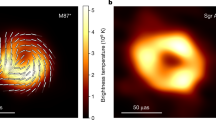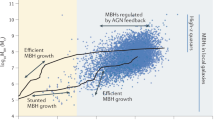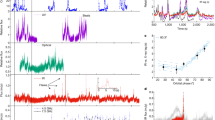Abstract
HAWKING has shown1 that black holes, treated quantum mechanically, emit black body radiation of temperature T = 10−7 (M⊙/M⊙) K, and hence evaporate—if isolated—on a time scale2 of ∼ 1066 (M/M⊙)3 yr. Energy arguments1,3,4 suggest that a black hole can be assigned the entropy  where SH ∼ 40(M/Mp)K is the entropy of a hydrogen cloud from which the black hole is assumed to have formed, Mp is the mass of the proton, and K is Boltzmann's constant. This implies that when a hydrogen cloud of mass 1M⊙ collapses into a black hole, the entropy of the (uncollapsed) galaxy [∼ 1012SH(M⊙) and more] would increase by a factor ∼ 106. In other words: something hardly observable, namely the collapse of one star, would increase the entropy of our cosmic neighbourhood by a large factor. We endeavour to resolve this apparent puzzle.
where SH ∼ 40(M/Mp)K is the entropy of a hydrogen cloud from which the black hole is assumed to have formed, Mp is the mass of the proton, and K is Boltzmann's constant. This implies that when a hydrogen cloud of mass 1M⊙ collapses into a black hole, the entropy of the (uncollapsed) galaxy [∼ 1012SH(M⊙) and more] would increase by a factor ∼ 106. In other words: something hardly observable, namely the collapse of one star, would increase the entropy of our cosmic neighbourhood by a large factor. We endeavour to resolve this apparent puzzle.
This is a preview of subscription content, access via your institution
Access options
Subscribe to this journal
Receive 51 print issues and online access
$199.00 per year
only $3.90 per issue
Buy this article
- Purchase on Springer Link
- Instant access to full article PDF
Prices may be subject to local taxes which are calculated during checkout
Similar content being viewed by others
References
Hawking, S. W., Nature, 248, 30 (1974); Commun. Math. Phys., 43, 199 (1975).
Page, D. N., Orange Aid Preprint 419 (Caltech, Pasadena, 1975).
Bekenstein, J. D., Phys. Rev. D., 7, 2333 (1973).
Bardeen, J. M., Carter, B., Hawking, S. W., Commun. Math. Phys., 31, 161 (1973).
Hawking, S. W., Orange Aid Preprint 412, (Caltech, Pasadena, 1975).
Davies, P. C. W., The Physics of Time Asymmetry, section 4, 6 (Surrey University Press, London, 1974).
Kundt, W., Origin of the Universe, Trends in Physics, (EPS publication, 1973).
Author information
Authors and Affiliations
Rights and permissions
About this article
Cite this article
KUNDT, W. Entropy production by black holes. Nature 259, 30–31 (1976). https://doi.org/10.1038/259030a0
Received:
Accepted:
Issue Date:
DOI: https://doi.org/10.1038/259030a0
Comments
By submitting a comment you agree to abide by our Terms and Community Guidelines. If you find something abusive or that does not comply with our terms or guidelines please flag it as inappropriate.



